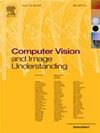Gaussian Splatting with NeRF-based color and opacity
IF 4.3
3区 计算机科学
Q2 COMPUTER SCIENCE, ARTIFICIAL INTELLIGENCE
引用次数: 0
Abstract
Neural Radiance Fields (NeRFs) have demonstrated the remarkable potential of neural networks to capture the intricacies of 3D objects. NeRFs excel at producing strikingly sharp novel views of 3D objects by encoding the shape and color information within neural network weights. Recently, numerous generalizations of NeRFs utilizing generative models have emerged, expanding their versatility. In contrast, Gaussian Splatting (GS) offers a similar render quality with faster training and inference as it does not need neural networks to work. It encodes information about the 3D objects in the set of Gaussian distributions that can be rendered in 3D similarly to classical meshes. Unfortunately, GS is difficult to condition since its representation is fully explicit. To mitigate the caveats of both models, we propose a hybrid model Viewing Direction Gaussian Splatting (VDGS) that uses GS representation of the 3D object’s shape and NeRF-based encoding of opacity. Our model uses Gaussian distributions with trainable positions (i.e., means of Gaussian), shape (i.e., the covariance of Gaussian), opacity, and a neural network that takes Gaussian parameters and viewing direction to produce changes in the said opacity.As a result, our model better describes shadows, light reflections, and the transparency of 3D objects without adding additional texture and light components.
高斯飞溅与nerf为基础的颜色和不透明度
神经辐射场(nerf)已经证明了神经网络在捕捉复杂的3D物体方面的巨大潜力。通过在神经网络权重中编码形状和颜色信息,nerf擅长于生成惊人的3D物体的新颖视图。最近,利用生成模型的nerf的许多概括已经出现,扩大了它们的多功能性。相比之下,高斯飞溅(GS)提供了类似的渲染质量,更快的训练和推理,因为它不需要神经网络来工作。它在一组高斯分布中编码关于3D对象的信息,这些信息可以像经典网格一样在3D中渲染。不幸的是,由于GS的表示是完全显式的,因此很难对其进行条件设置。为了减轻这两种模型的缺点,我们提出了一种混合模型,即使用GS表示3D物体的形状和基于nerf的不透明度编码。我们的模型使用高斯分布,具有可训练的位置(即高斯均值),形状(即高斯的协方差),不透明度和一个神经网络,该神经网络采用高斯参数和观察方向来产生所述不透明度的变化。因此,我们的模型可以更好地描述阴影、光反射和3D物体的透明度,而无需添加额外的纹理和光组件。
本文章由计算机程序翻译,如有差异,请以英文原文为准。
求助全文
约1分钟内获得全文
求助全文
来源期刊

Computer Vision and Image Understanding
工程技术-工程:电子与电气
CiteScore
7.80
自引率
4.40%
发文量
112
审稿时长
79 days
期刊介绍:
The central focus of this journal is the computer analysis of pictorial information. Computer Vision and Image Understanding publishes papers covering all aspects of image analysis from the low-level, iconic processes of early vision to the high-level, symbolic processes of recognition and interpretation. A wide range of topics in the image understanding area is covered, including papers offering insights that differ from predominant views.
Research Areas Include:
• Theory
• Early vision
• Data structures and representations
• Shape
• Range
• Motion
• Matching and recognition
• Architecture and languages
• Vision systems
 求助内容:
求助内容: 应助结果提醒方式:
应助结果提醒方式:


